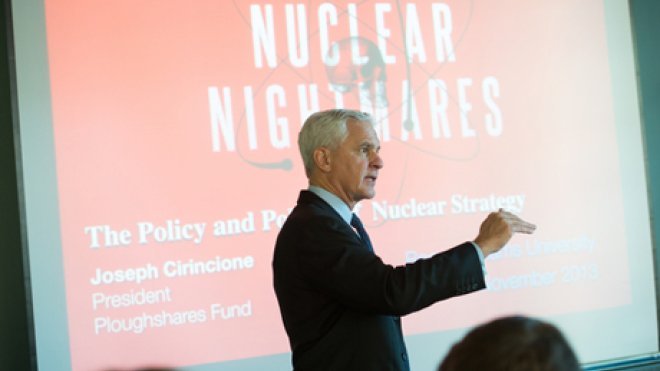Cirincione: 'Nuclear Nightmares' Threaten Planetary Destruction
Ploughshares Fund President, global security expert Joseph Cirincione outlines nuclear threats, predicts progress with Iran at President's Distinguished Speakers Series lecture

BRISTOL, R.I. – On January 23, 1961, two Mark 39 hydrogen bombs – a nuclear weapon considered to be 260 times more powerful than the atomic bombs that annihilated Nagasaki and Hiroshima – came cataclysmically close to detonating over Goldsboro, N.C., when a B-52 broke up in flight during a routine Cold War alert mission. As the bombs descended, six safety mechanisms failed – leaving just one switch to prevent a nuclear catastrophe.
“Mistakes are made, people miscalculate,” said global security expert Joseph Cirincione during a recent visit to RWU. “Accidents have happened.”
It’s a sobering statement, considering how secure most Americans believe the U.S. nuclear weapons stash to be. (It may not be. Consider this: just a few years ago, a B- carrying six cruise missiles made its way to Louisiana and sat loosely secured on a tarmac overnight before anyone noticed the red dots indicating they were nuclear missiles. No one on the originating end noticed they were missing. “If that’s happening in this country, with the best command and control in the world,” Cirincione said, “what’s happening in Russia and Pakistan?”)
There are 17,000 nuclear weapons in the world today. Of the 8,000 in U.S. possession, 5,000 are active; 2,000 are deployed; 1,000 are ready to launch in under 15 minutes. And, Cirincione noted, these are not our grandfather’s bombs. They are up to 50 times stronger and more lethal than the atomic bombs that ended WW-II, and threaten complete global destruction.
“There are multiple nuclear nightmares out there,” said Cirincione, who heads the Ploughshares Fund, a grant-funding organization that has provided $100 million to projects and programs that will eliminate the threat of nuclear weapons worldwide. “It could happen overnight and cause catastrophes unlike anything we’ve ever seen.”
Among those nightmare scenarios, which Cirincione outlines in his forthcoming book, “Nuclear Nightmares: Securing the World Before it’s Too Late,” are regional nuclear war in South Asia; new nations, such as North Korea and Iran, acquiring nuclear weapons; and nuclear terrorism – the top threat to U.S. national security, according to Cirincione. If a terrorist organization, like Al Qaeda, were to get ahold of a nuclear weapon, “we would have nuclear 9/11,” he said.
“It’s hard to get a weapon, but they could get the components to make one,” Cirincione said. “Making a bomb is hard, but it’s not all that difficult. It would be harder for us to stop them, once they’ve acquired the materials.”
And while the media may have Americans believing that Iran is the world’s biggest nuclear threat, Cirincione points elsewhere:
“Pakistan is the most dangerous country on Earth,” he said. “They currently have 100 nuclear weapons, are continuing to develop more and Al Qaeda is operating in its borders.”
In fact, he said, Iran may be the one problem that is being solved. For the first time in history, leaders in both countries have expressed interest in working together to secure and limit Iran’s nuclear weapons as the failing country attempts to get back on track, improve its economy and be re-integrated in its region. The only way to do that, Cirincione said, is to make a deal on the nuclear program.
“We are watching the hinge of history move,” he said, predicting a possible deal this week as world leaders convene in Geneva. “It won’t be all at once – it’s not a breakthrough deal – but the first steps will be to limit uranium and increase inspections. There can be no secret enrichment sites. It will take nine to 12 months, but if they can do that, it will change the geopolitics and strategic situation in the Middle East.”
Cirincione, who spent the day at Roger Williams meeting students for a master class and luncheon, fielded dozens of questions following the lecture providing insight on the NSA scandal and international relations (“they’re killing us!”) to drone strikes (they’re making the terrorism problem worse, he said) and the lack of gender diversity in the U.S. political system. And while he acknowledged the seemingly insurmountable challenges to freeing the world of nuclear weapons, Cirincione offered a hopeful parting message for the emerging generation of leaders: it’s not impossible.
“Things people say are impossible means they are just really hard. The impossible happens all the time,” Cirincione said, offering the end of the Soviet Era, Nelson Mandela’s presidency and the Boston Red Sox’s three World Series championships as evidence. “I believe that what I do has a huge effect, and I want you to believe that you can impact this huge issue, too. You can make a difference. You can do something about this – you just have to have faith that you can change the world.”